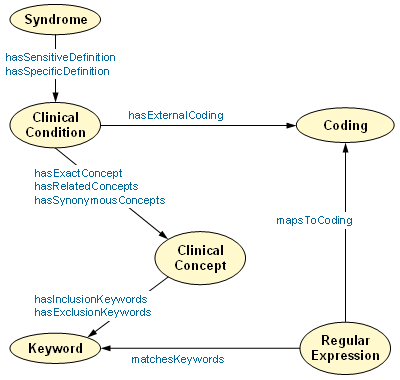The Ontology
The SSO is developed in OWL (web ontology language) using Protege 3.4.1. You can download the current version of the ontology here:
- SSO version 1.0 [owl file]
You can also use our onto-browser to view the contents of the ontology online.
Concepts. In SSO, three main classes describe fundamental knowledge about clinical syndromes used for public health surveillance: Syndrome, Clinical Condition (member of sensitive or specific definition of a syndrome), and Clinical Concept (used to define clinical conditions). Additional classes: Keyword, Regular Expression and Coding are used to link syndrome definitions to their potential applications (e.g. chief complaint classifier), and to major external coding systems and vocabularies (e.g. UMLS). Particular syndromes, clinical conditions, and concepts are encoded as the subclasses of the corresponding main classes, for example Respiratory Syndrome is a subclass of Syndrome, while Apnea is a subclass of Clinical Condition.

Properties. Relationships among the classes are encoded using OWL properties. For example, one of the properties of the Syndrome class is hasSensitiveDefinition, which can be filled in by multiple Clinical Conditions. It is the values of these properties that distinguish among different syndromes, clinical conditions and clinical concepts. For example, both ILI Syndrome and GastroIntestinal Syndrome have sensitive definition, but their sensitive definitions are not the same. One way to express these differences would be to add restrictions to class definitions. Alternatively, these classes can be created as instances of OWL meta-classes, so that a specific value can be assigned to each class property (same as for OWL individuals). We have chosen the second option that provides better human readability.
Individuals. Specific keywords and regular expressions used to match clinical concepts are encoded as instances of corresponding classes.


